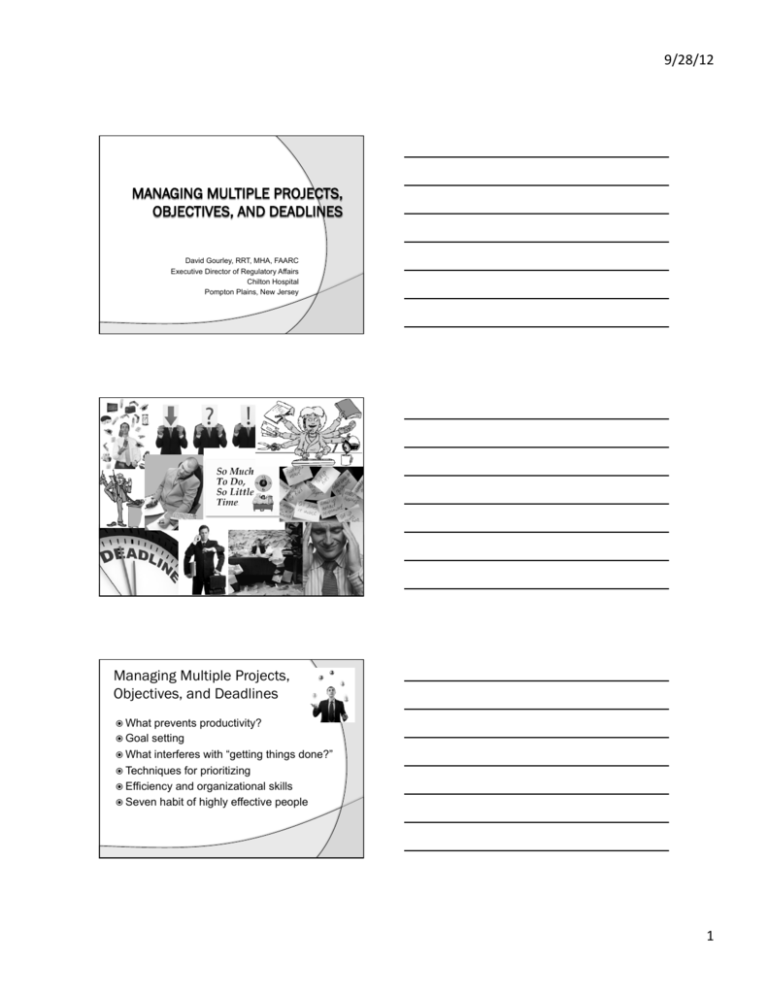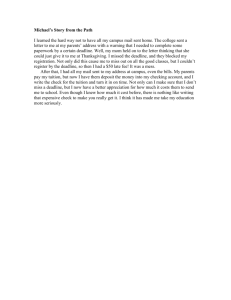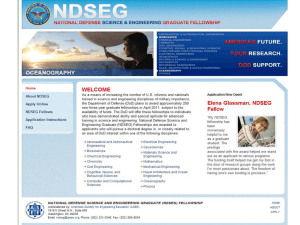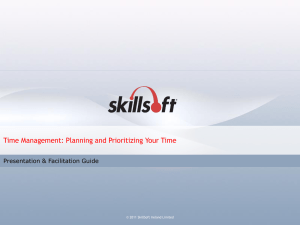Managing Multiple Projects, Objectives, and Deadlines.pptx
advertisement

9/28/12 David Gourley, RRT, MHA, FAARC Executive Director of Regulatory Affairs Chilton Hospital Pompton Plains, New Jersey Managing Multiple Projects, Objectives, and Deadlines What prevents productivity? setting What interferes with “getting things done?” Techniques for prioritizing Efficiency and organizational skills Seven habit of highly effective people Goal 1 9/28/12 Which of these block your productivity? Procrastination Disorganization Interruptions Too many commitments Unnecessary correspondence Meetings without goals Inability to say “NO” Unclear objectives Too much socializing Ineffective delegation Confusion about priorities Unrealistic time frames Negativity Poor communication Other people’s mistakes Understaffing Lack of feedback Shifting priorities Perfection Paperwork Too many appointments Capturing Every Task Master “To Do” List (what do you do all day?) your calendar or appointment book Make a notation every 30 minutes Note interruptions Determine what activities make up the day What time is dedicated to each? Carry 2 9/28/12 Capturing Every Task Telephone calls Drop-in visitors Meetings Paperwork Reading Seeing the boss Assisting staff Emergencies Budget Travel time Planning Delegating HR issues Organizing Relaxation Computer work Chatting Personal business Planning an Effective Week Every Thursday or Friday schedule for following week Ensure pre-scheduled events are recorded Prioritize intermediate and long range projects and schedule time Schedule time for yourself Build in “cushions” “Commute time” Review 3 9/28/12 Planning an Effective Week “Do or advance” Activity Priority Est. Time Complete capital requests 1 2 hours Meet with Sales Rep regarding new ABG analyzer 2 1 hour Develop in-service for ICU staff 3 2 hours Work on performance reviews 4 4 hours Complete after action report from recent power failure 5 30 minutes Perform annual policy review 6 4 hours Revise PI plan for 2013 7 2 hours High Quality (SMART) Goals Specific Measurable Attainable Realistic/Relevant Time bound 4 9/28/12 High Quality (SMART) Goals Specific Straightforward WHAT are you going to do? (Direct, organize, coordinate, lead, develop, plan, build, etc. WHY is this important to do at this time? What do you want to ultimately accomplish? HOW are you going to do it? (By…) High Quality (SMART) Goals Measureable “If you can’t measure it, you can’t manage it” Establish concrete criteria to measure progress Assists with staying on track How will you know when the goal is accomplished? High Quality (SMART) Goals Attainable Reaching benchmarks will keep you performing Not beyond reach, nor trivial “How can the goal be accomplished?” 5 9/28/12 High Quality (SMART) Goals Relevant Does the goal matter? Does this seem worthwhile? Is this the right time? Does it match the organization goals? Are you the right person? High Quality (SMART) Goals Time bound When? What can I do 6 months from now? What can I do 6 weeks from now? What can I do today? 6 9/28/12 Techniques for Prioritizing Item Deadline Payoff Weighted Score + = + = + = + = + = Deadline 1 = long-term 2 = intermediate 3 = short term Rank Payoff 1 = Low impact 2 = Moderate impact 3 = High impact Techniques for Prioritizing Item Deadline Payoff Weighted Score Rank Complete capital requests 2 + 2 = 4 4 Meet with Sales Rep 3 + 1 = 4 3 Develop in-service 2 + 3 = 5 2 Work on Performance reviews 3 + 3 = 6 1 Revise PI plan for 2013 1 + 2 = 3 5 Deadline 1 = long-term 2 = intermediate 3 = short term Payoff 1 = Low impact 2 = Moderate impact 3 = High impact Techniques for Prioritizing # Item Check Rank Compare 1 1-2, 1-3, 1-4, 1-5 2 2-3, 2-4, 2-5 3 3-4, 3-5 4 4-5 5 Use when you only have enough time to do or advance one item, which should you choose? *Any item from an authority figure takes priority **Better than a “gut feeling” 7 9/28/12 Techniques for Prioritizing # Rank Compare 1 Complete capital requests Item Check 4 1-2, 1-3, 1-4, 1-5 2 Meet with Sales Rep 2 2-3, 2-4, 2-5 3 Develop in-service 3 3-4, 3-5 4 Work on Performance reviews 1 4-5 5 Revise PI plan for 2013 5 Use when you only have enough time to do or advance one item, which should you choose? *Any item from an authority figure takes priority **Better than a “gut feeling” Refining Efficiency and Organizational Skills What activities take the majority of my time? What activities should be given more time? What activities should be given less time? Refining Efficiency and Organizational Skills Does this activity really need to be done? Does it need to be done by me? Can it be shared? What is the deadline? Can it be done in parts over time? Can it be combined with other activities? Is there a faster, easier way to do it? 8 9/28/12 Four Quadrants of Time Management URGENT NOT URGENT I M P O R T A N T Crises Emergencies Dealing with irate patient/family Addressing urgent staffing issue Discipline issues Pressing problems Drop-ins Preparation Goal setting Planning/organizing Team building Brainstorming N O T I M P O R T A N T Unnecessary reports Other people’s major issues Organizational politicking Effects of procrastination Needless interruptions Trivia Busywork Irrelevant emails Excessive paperwork Gossip Time wasters/time robbers INCREASE THESE DECREASE THESE Project Management Define the project the work breakdown structure Estimate time and budget Develop a schedule Monitor the project’s progress Control the project Close it out Develop 9 9/28/12 Project Management Gantt Chart Developed by Henry Gantt during World War 1 Timeline chart showing sequence of tasks Identifies start and finish dates Provides easy interpretation of project data Determine resource requirements Define who must perform each function Project Management Why is project planned? Personal Financial Competitive Safety Regulatory Gantt Chart - Readmissions Time Estimate Predecessors 1 Needs analysis 30 days NA 2 Collaborate with external partners (Home health agencies, DME providers) 60 days 1 3 Develop multi-disciplinary program to reduce COPD readmissions 30 days 1, 2 4 Presentation to Physicians, Senior Management, RT and RN staff 14 days 3 5 Staff education for RTs and RNs 14 days 3, 4 6 Implement Readmission program 90 days 4, 5 7 Collect, aggregate, and analyze data 14 days 6 8 Evaluation of program by PI Committee 14 days 7 Task # Task Name 10 9/28/12 Gantt Chart Seven Habits of Highly Effective People 1. 2. 3. 4. 5. 6. 7. Be proactive Begin with the end in mind First things first Think win/win Seek first to understand, then to be understood Synergize Sharpen the saw 11 9/28/12 Be Proactive Taking responsibility on things you can control Focus on your “Circle of Influence” Focus Begin With the End in Mind Based on imagination mental creation precedes the physical creation Develop a personal mission statement Creates your own destiny The Put First Things First Organizes Manages your time the events 12 9/28/12 Think Win-Win Code of collaboration is not a “Zero sum” game Cooperative, not competitive Approaching conflict “win-win” requires three traits: Life Integrity Maturity Abundance mentality Seek First to Understand…. ….then to be Understood Communication is the most important skill in life From listening autobiographically, we tend to respond: Evaluating – judge, then agree or disagree Probing – ask questions from own frame of reference Advising – give counsel, advice, or solutions Interpreting – Analyze others motives or behaviors Synergize Teamwork Open-mindedness Valuing differences drives synergy 13 9/28/12 Sharpen your Saw Preserving and enhancing you!! program for self-renewal Physical, social, mental, and spiritual Balanced Bibliography Carroll, John, Project Management, 2009 Covey, Stephen, Seven Habits of Highly Effective People, 1989 Dobson, Michael, The Juggler’s Guide to Managing Multiple Priorities, 1999 Fred Pryor Seminars, Managing Multiple Priorities Shirley, David, Project Management in Healthcare, 2011 Tobis, Irene and Michael, Managing Multiple Priorities, 2002 14 9/28/12 Questions 15





